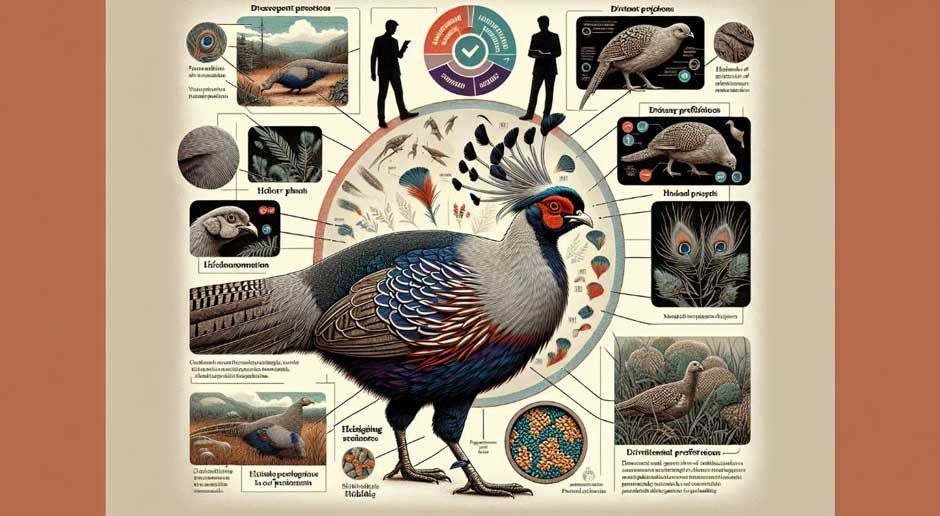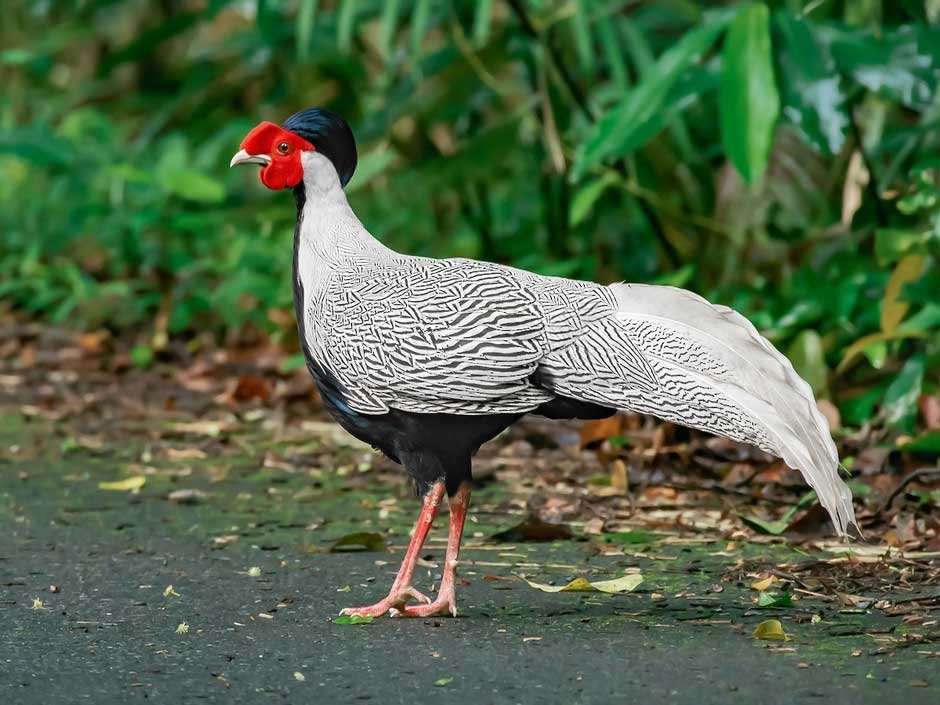The silver pheasant, a strikingly beautiful bird, has fascinated aviculturists and bird enthusiasts alike for centuries. With its distinctive appearance and vibrant behavior, the silver pheasant not only plays a crucial role in its natural habitat but also adds a unique charm to aviculture. Its importance extends beyond mere aesthetics, serving as a symbol of grace and agility in various cultures. As we delve into the world of the silver pheasant, understanding its origins, characteristics, and relationship with humans becomes essential. This bird’s ability to adapt to various environments while retaining its majestic beauty underscores its significance within the avian community.
This article aims to cover everything one needs to know about the silver pheasant, starting from its origins and taxonomy, which lay the groundwork for understanding its place in the natural world. A detailed exploration of the bird’s physical description and sexual dimorphism reveals the diversity and complexity of its species. Additionally, we will look into its habitat and distribution to understand the environmental contexts the silver pheasant thrives in. The discussion on aviculture and human interaction highlights its value and challenges in captivity, offering insights into conservation efforts. Concluding with a reflection on its overall significance, this piece provides a comprehensive overview of the silver pheasant, merging scientific facts with its broader ecological and cultural impact.

Origins and Taxonomy
Originally classified by Carl Linnaeus in the 1758 10th edition of Systema Naturae, the silver pheasant was placed in the genus Phasianus. Over the years, the classification of the silver pheasant and its subspecies has seen considerable debate, with placements in either Euplocamus or Gennceus. Presently, all major authorities recognize the silver pheasant under the genus Lophura.
Historical classification challenges
The taxonomic journey of the silver pheasant highlights the complexities inherent in avian classification. Initial placement in the genus Phasianus was followed by a period of reclassification into Euplocamus and Gennceus. This reflects the evolving understanding of the species’ relationships within the pheasant family. The debate over the correct genus underscores the challenges faced by taxonomists in accurately categorizing birds based on morphological and genetic data.
Current scientific classification and major subspecies
Today, the consensus places the silver pheasant within the genus Lophura. This genus also includes closely related species such as the kalij pheasant, with which the silver pheasant is known to hybridize. The taxonomy of specific taxa, namely L. n. lineata and L. n. crawfurdi, has been contentious, with some sources treating them as subspecies of the kalij pheasant and others as subspecies of the silver pheasant. These taxa are distinguished by their leg coloration and plumage, which bear similarities to both the kalij and silver pheasants. Their distribution east of the Irrawaddy River, a significant zoogeographic barrier, further complicates their classification. However, recent mitochondrial DNA analysis supports their classification as subspecies of the kalij pheasant.
The silver pheasant is native to southern China, Burma, Thailand, Vietnam, and Cambodia, inhabiting a variety of habitats. Jean Delacour has identified 14 subspecies, with the True Silver Pheasant (Lophura nycthemera nycthemera) being the most commonly kept in aviculture. This subspecies is the largest and is found in southeastern China. Other notable subspecies include the Lewis’s Silver Pheasant, Annamese Silver Pheasant, and the Hainan Silver Pheasant, among others.
Hybridization with other pheasants
Hybridization plays a significant role in the genetic diversity of the silver pheasant. Notably, the imperial pheasant, once considered a distinct species, is now recognized as a naturally occurring hybrid between the silver pheasant and the Vietnamese pheasant. This discovery underscores the fluidity of species boundaries and the importance of genetic studies in clarifying the relationships between closely related taxa. Additionally, the silver pheasant’s capacity to hybridize with the kalij pheasant further highlights the complex interplay between species within the Lophura genus.
In summary, the origins and taxonomy of the silver pheasant reflect the dynamic nature of scientific classification. Through ongoing research and genetic analysis, our understanding of this species and its relationship with other pheasants continues to evolve, offering insights into the biodiversity and evolutionary history of the avian world.
Physical Description and Dimorphism
The physical attributes and sexual dimorphism of the silver pheasant present a fascinating study in avian biology, showcasing significant differences in size, coloration, and plumage between males and females, as well as variations across different subspecies.
Comparison between males and females
The silver pheasant exhibits pronounced sexual dimorphism, with males being notably larger than females. Males of the largest subspecies can reach a total length of 120 to 125 cm, including a tail up to 75 cm, and weigh between 1.13–2.00 kg. In contrast, females are smaller, measuring 55–90 cm in total length, including a tail of 24–32 cm, and weigh between 1.0–1.3 kg. This size disparity adds an intriguing dynamic to their appearance, with males showcasing more vibrant and elaborate plumage compared to the more subdued coloration of females.
Males typically have white or grey upperparts and tail, with extensive black markings, especially in the northern subspecies, which appear far darker than their southern counterparts. Their underparts and crest are glossy bluish-black. Females, on the other hand, are generally brown with shorter tails. Some subspecies of females exhibit whitish underparts strongly patterned with black, adding to the diversity within the species.
Variations across subspecies
The silver pheasant’s plumage varies significantly across its subspecies, influenced by geographical distribution. The northern subspecies’ males are characterized by their white upperparts and tail, with most feathers having some black markings, while the southern subspecies’ males have greyer upperparts and tail with more extensive black markings. This variation underscores the adaptability of the species to different environments, contributing to the complexity of its classification.
Changes in plumage over time
The journey to full coloration in silver pheasants is a gradual process, taking about two years for males to achieve their brilliant plumage. Initially, first-year males often display many black markings on the chest, with the rest of the body being mostly brown with light gray streaks. It is only in their second year that males reach adult plumage, marked by the development of long black crests, black chins and throats, and glossy bluish-black bellies. The tail feathers also undergo significant changes, with central feathers becoming pure white, and the bright red face wattles, used during courtship, become more prominent.
This transformation underscores the complexity and beauty of the silver pheasant’s development, from the more muted tones of youth to the strikingly vibrant colors of adulthood. The variations in plumage not only highlight the diversity within the species but also serve as a key factor in sexual selection, with the more brightly colored males likely having an advantage in attracting mates.
Habitat and Distribution
The silver pheasant ( Lophura nycthemera ) is a species that exhibits a broad geographical range, primarily found in the forests, mainly in mountains, of mainland Southeast Asia and eastern and southern China. This bird species has adapted to a variety of habitats but shows a preference for forest edges with open areas, avoiding dense forest environments. The following sections delve into the specifics of their natural habitats, introduced populations, and the conservation status that impacts their distribution.

Natural habitats across Southeast Asia and China
Silver pheasants are native to a wide area across mainland Southeast Asia and China, thriving in environments that offer a blend of forested areas and open spaces. These habitats are predominantly located in mountainous regions where they have access to a rich biodiversity of flora and fauna, contributing to their diet and nesting preferences. The vegetation in these habitats mainly consists of species like Castanopsis carlesii, C. eyrie, Lithocarpus glaber, and Schima superba, among others. During different seasons, silver pheasants show adaptability by preferring steeper areas, which may serve as a strategy to avoid predation, especially during the rearing of young chicks. This adaptability to various terrains and vegetation types underscores their resilience in the wild.
Introduced populations worldwide
Beyond their natural range in Asia, silver pheasants have been introduced to other parts of the world, including Victoria Island in Nahuel Huapi Lake, Neuquén, Argentina, and on Vancouver Island, Canada. These introductions have allowed the species to adapt to new environments, although the long-term impacts on local ecosystems and the silver pheasant populations themselves are subjects of ongoing study. The presence of silver pheasants in these non-native habitats showcases their adaptability, although it also raises questions about the implications for native species and biodiversity.
Conservation status and threat factors
While the silver pheasant remains common in the wild overall, certain subspecies face threats that have led to their classification as rare and endangered. Notably, subspecies such as L. n. whiteheadi from Hainan, L. n. engelbachi from southern Laos, and L. n. annamensis from southern Vietnam are considered rare and face threats primarily due to habitat degradation and loss. The International Union for Conservation of Nature (IUCN) lists the silver pheasant as Least Concern (LC), with an estimated population size in China consisting of 10,000-100,000 breeding pairs. However, the numbers of silver pheasants are on a declining trend, highlighting the need for continued conservation efforts to mitigate the impacts of habitat loss, degradation, and other anthropogenic factors.
In conclusion, the habitat and distribution of the silver pheasant across its natural and introduced ranges present a complex picture of a species that is adaptable yet facing significant conservation challenges. Efforts to preserve their habitats and mitigate threats are crucial for ensuring the continued survival and diversity of silver pheasant populations worldwide.
Aviculture and Human Interaction
Keeping Silver Pheasants in Captivity
Silver pheasants are commonly kept in captivity due to their striking appearance and adaptability. For optimal health and safety, these birds require an aviary with a minimum space of 200 square feet, which should be increased proportionally when housing more than three birds. The aviary design should prevent accidents, such as birds injuring themselves by flying upward during fright, by incorporating soft netting rather than wire mesh at the top. Additionally, the aviary must be secure from predators like foxes and must include preventive measures such as deep-set wire meshes underground to prevent digging.
Vermin control is crucial, as mice and rats can pose significant health risks and consume food meant for the pheasants. Employing traps and careful placement of poison, ensuring it is inaccessible to the birds, can help manage these pests effectively. Moreover, providing a varied landscape within the aviary, including brush and perches, can help mimic their natural habitat, which is essential for their well-being in captivity.
Dietary Preferences and Breeding Habits
Silver pheasants exhibit specific dietary preferences that include a mix of gamebird pellets, fruits like blueberries and watermelon, and vegetables. Care should be taken with certain fruits like grapes, which must be chopped to prevent choking hazards. These birds also consume a variety of insects such as mealworms and crickets, which are vital for their protein intake. During the breeding season, their diet can be supplemented with higher protein feeds to support egg production.
Breeding silver pheasants in captivity requires attention to their natural polygynous nature, where one male may mate with several females. The breeding season typically spans from late February to May, with females laying 6-12 eggs, which can increase if the eggs are consistently removed from the nest. It is also noted that males reach full maturity and coloration in their second year, although they may be fertile before then.
The Role of the Silver Pheasant in Culture and Art
The silver pheasant holds significant cultural value in various regions, particularly in Asia. In traditional Chinese culture, the silver pheasant is associated with the fifth civil rank, often depicted in art and embroidery with its distinct white plumage and serrated tail feathers. The bird’s representation in cultural artifacts is not only a testament to its beauty but also to its cultural symbolism of grace and nobility.
Moreover, the silver pheasant’s role extends into contemporary settings where its image is used in digital art and design, reflecting its integration into modern cultural expressions. This ongoing cultural significance highlights the silver pheasant’s role not just as a species within aviculture but also as a continuing symbol in human art and society.
Conclusion
Through the exploration of the silver pheasant’s origins, taxonomy, physical characteristics, habitat, and human interactions, we’ve unravelled the intricate tapestry that constitutes its life and significance. The journey from understanding its classification struggles to its vibrant presence in aviculture illuminates the bird’s resilience and adaptability, showcasing the intersection between nature’s marvels and human curiosity. The deep dive into its physical dimorphism, habitat preferences, and the cultural significance further enriches our appreciation for this majestic bird, offering a holistic view that transcends mere aesthetics.
The narrative of the silver pheasant serves as a reminder of the delicate balance within ecosystems and the pivotal role conservation plays in sustaining species diversity. As we reflect on the silver pheasant’s broader implications, it becomes clear that our efforts in conservation, research, and responsible aviculture contribute not only to the survival of this particular species but also to the broader ecological health and cultural heritage. It encourages a renewed commitment to preserving our natural world, suggesting avenues for future research and conservation initiatives that will ensure the silver pheasant continues to thrive in both the wild and human domains.
FAQs
What Should You Know About Silver Pheasants?
Q: Can you share some captivating details about silver pheasants?
A: Silver pheasants are distinguished by their striking appearance and behavior. The males boast an impressive white and black plumage, while females are primarily brown with smaller facial wattles and a modest black crest. Both genders have distinctive bare, red legs. These birds are native to Southeast Asia, where they inhabit high-altitude forests. They belong to a group with many subspecies, adapting to various environments within their range.
Q: Do silver pheasants exhibit aggressive behavior?
A: Male silver pheasants have a tendency to show aggression towards both their keepers and female counterparts. This behavior varies among individuals; some may require a keeper to use a stick or broom for safety, while others are docile enough to eat directly from a person’s hand. Regardless of their temperament, silver pheasants are robust and resilient birds.
Q: How do silver pheasants behave in their natural habitat?
A: Silver pheasants are sociable, ground-dwelling birds often found in small groups. They are diurnal, with peak activity for foraging occurring in the early morning and late evening. Although they spend most of their time on the ground, they are capable of flight when they need to escape predators or danger.
Q: At what age do silver pheasants begin to lay eggs, and what are their laying habits?
A: Silver pheasants start laying eggs during their first year of life. While males only achieve their full adult plumage in their second year, they are fertile and can reproduce in their first year. The egg-laying season begins in March, with the female laying an egg every second day until she reaches a total of around 20+ eggs. These eggs are medium-sized and have a pinkish-cream color.
